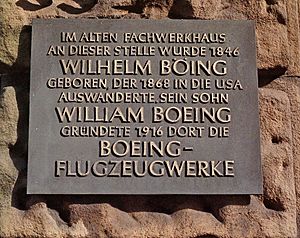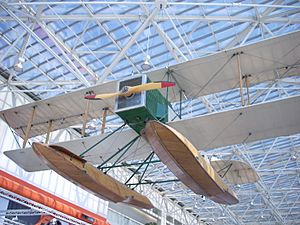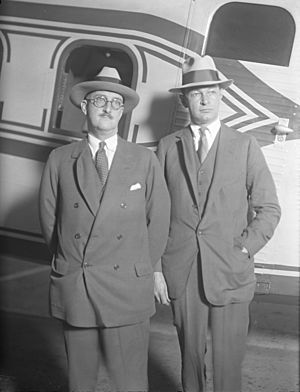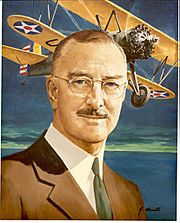William E. Boeing facts for kids
Quick facts for kids
William E. Boeing
|
|
|---|---|
 |
|
| Born |
William Edward Boeing
October 1, 1881 Detroit, Michigan, U.S.
|
| Died | September 28, 1956 (aged 74) Puget Sound, Washington, U.S.
|
| Nationality | American |
| Citizenship | American |
| Education | Yale University |
| Occupation | Industrialist |
| Known for | Founder of Boeing |
| Spouse(s) |
Bertha M. Potter Paschall Boeing
(m. 1921) |
| Children | William E. Boeing Jr. |
| Awards | Daniel Guggenheim Medal (1934) |
| Signature | |
 |
|
William Edward Boeing ( October 1, 1881 – September 28, 1956) was an American aviation pioneer who founded the Pacific Airplane Company in 1916, which a year later was renamed to The Boeing Company. He also helped create the United Aircraft and Transport Corporation (known as "United Airlines" today) in 1929 and served as its chairman.
Contents
Early life
William Boeing was born in Detroit, Michigan, to Marie M. Ortmann, from Vienna, Austria, and Wilhelm Böing (1846–1890) from Hohenlimburg, Germany. Wilhelm Böing emigrated to the United States in 1868 and initially worked as a laborer. Wilhelm's father did not approve his move to America, so he gave his son no financial support. Wilhelm later made a fortune from North Woods timber lands and iron ore mineral rights on the Mesabi Range of Minnesota, north of Lake Superior.
In 1890, when William was eight, his father died of influenza and his mother soon remarried. He attended school in Vevey, Switzerland, and returned to the US for a year of prep school in Boston. He enrolled at Yale University in New Haven, Connecticut. He dropped out in 1903 to go into the lumber business.
Career
Boeing moved to Hoquiam, Washington, in the Pacific Northwest. He was successful in the venture. He was shipping lumber to the East Coast via the then-new Panama Canal. He earned a lot of money to start a very different business.
At the Alaska-Yukon-Pacific Exposition in 1909, Boeing saw a manned flying machine for the first time and became fascinated with aircraft. He took flying lessons at Glenn L. Martin Flying School in Los Angeles and purchased one of Martin's planes.
Martin pilot James Floyd Smith traveled to Seattle to assemble Boeing's new Martin TA hydroaeroplane and continue to teach its owner to fly. Smith assembled the plane, parts of which had arrived by train, in a tent hangar that was built on the shore of Lake Union. Boeing's test pilot, Herb Munter, soon damaged the plane.
When he was told by Martin that replacement parts would not be available for months, Boeing told his friend, Commander George Conrad Westervelt of the US Navy, "We could build a better plane ourselves and build it faster." Westervelt agreed. They soon built and flew the B & W Seaplane, an amphibian biplane that had outstanding performance. Boeing decided to go into the aircraft business. He used an old boat works on the Duwamish River near Seattle for his factory.
Founding of Boeing Aircraft
In 1916, Boeing went into business with George Conrad Westervelt. They named their plane "B & W" and founded Pacific Aero Products Co. The company's first plane was the Boeing Model 1 (B & W Seaplane). When America entered the First World War on April 8, 1917, Boeing changed the name to Boeing Airplane Company and obtained orders from the US Navy for 50 planes. At the end of the war, Boeing concentrated on commercial aircraft to service airmail contracts.
International airmail attempt
On March 3, 1919, Willam Boeing together with Eddie Hubbard made the first delivery of international airmail to the United States. They flew a Boeing C-700 seaplane for the demonstration trip from Vancouver, British Columbia, to Seattle's Lake Union, carrying a bag of 60 letters from the Canadian post office for delivery in the U.S.
Breakup of Boeing Group
In 1929, Boeing and Frederick Rentschler of Pratt & Whitney formed United Aircraft and Transport Corporation. The new company was interested in all aspects of aviation and intended to serve all aviation markets. In a short time, it bought a host of small airlines and merged them with Boeing's pioneering airline under a holding company, United Air Lines.
In 1934, the United States government accused William Boeing of monopolistic practices. The same year, the Air Mail Act forced airplane companies to separate flight operations from development and manufacturing. William Boeing gave up his ownership rights. His holding company, United Aircraft and Transport Corporation, broke into three separate entities:
- United Aircraft Corporation, holding the former eastern US manufacturing (later United Technologies Corporation)
- Boeing Airplane Company, with western US manufacturing, which later became The Boeing Company
- United Air Lines for flight operations
Personal life and family
In 1921, Boeing married Bertha Marie Potter Paschall (1891-1977). She had previously been married to Nathaniel Paschall, a real estate broker with whom she had two sons, Nathaniel "Nat" Paschall Jr. and Cranston Paschall. The couple had a son of their own, William E. Boeing Jr. (1922–2015). The stepsons went into aviation manufacturing as a career. Nat Paschall was a sales manager for competitor Douglas Aircraft, which later became McDonnell Douglas. Bill Jr. became a private pilot and industrial real estate developer.

Attitude to segregation
William Boeing and his wife Bertha favored segregation. Between 1935 and 1944, they bought a a large tract of land north of the Seattle to built residential communities on it. The Boeings placed racial restrictions, forbidding properties from being "sold, conveyed, rented, or leased in whole or in part to any person not of the White or Caucasian race." Non-whites could only occupy a property on the land if they were employed as a domestic servant "by a person of the White or Caucasian race."
Later life and death
In his later years, Boeing became a property developer. He purchased a 650-acre (260 ha) farm in the countryside east of Seattle, which he dubbed "Aldarra." The estate remained in the family until most of the land was developed into a golf course residential community in 2001. Several acres, however, remained in the family, including the Boeing's own and two smaller houses. His primary residence for most of his life, however, was a mansion in The Highlands community close to Seattle; the William E. Boeing House was later listed on the National Register of Historic Places. Boeing Creek running near this property bears his name.
William Boeing died on September 28, 1956, at the age of 74, three days before his 75th birthday. He was pronounced dead on arrival at the Seattle Yacht Club, having had a heart attack aboard his yacht, Taconite, in Puget Sound, Washington. His ashes were scattered off the coast of British Columbia, where he spent much of his time sailing.
In 2005, he son William Boeing Jr. said of his father:
"He loved watching birds, believed in reducing risk by focusing on facts and realized long before other people that commercial aviation had a place on the globe. He was someone who pursued his curiosity, studied things carefully and never dismissed the novel."
Interesting Facts about William Boeing
- The Boeing Company is now the largest exporter in the United States by dollar value and among the largest aerospace manufacturers in the world.
- William Boeing's first design was the Boeing Model 1 (or B & W Seaplane), which first flew in June 1916.
- He was posthumously inducted into the National Aviation Hall of Fame in Dayton, Ohio, in 1966, ten years after his death.
- He received the Daniel Guggenheim Medal in 1934.
- Before creating an aircraft, Boeing had experimented with boat design.
- Boeing loved horses. He began investing most of his time into thoroughbred horse breeding in 1937.
- On May 14, 1954, William Boeing and his wife Bertha went back to the Boeing Airplane Company to participate in the rollout ceremony for the Boeing 367-80 prototype.
- The Museum of Flight, in Seattle holds the William E. Boeing Sr. Papers; an archival collection of Boeing's textual and photographic materials.
- In 1984, Boeing was inducted into the International Air & Space Hall of Fame at the San Diego Air & Space Museum.
William Boeing quotes
- "Science and hard work can lick what appear to be insurmountable difficulties."
- "We are embarked as pioneers upon a new science and industry in which our problems are so new and unusual that it behooves no one to dismiss any novel idea with the statement that ‘it can’t be done!’"
- "I've tried to make the men around me feel… that we are embarked as pioneers."
See also
 In Spanish: William E. Boeing para niños
In Spanish: William E. Boeing para niños





